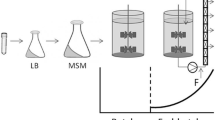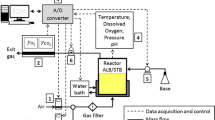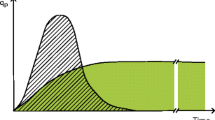Abstract
Escherichia coli is widely used host for the intracellular expression of many proteins. However, in some cases also secretion of protein from periplasm was observed. Improvement of both intracellular and extracellular production of recombinant protein in E. coli is an attractive goal in order to reduce production cost and increase process efficiency and economics. Since heat shock proteins in E. coli were reported to be helpful for protein refolding and hindering aggregation, in this work different types of single and periodic heat shocks were tested on lab scale to enhance intracellular and extracellular protein production. A single heat shock prior to induction and different oscillatory temperature variations during the induction phase were executed. The results showed that these variations influence protein production negatively. In other words, 45 and 50 % reduction in extracellular protein production were observed for the single heat shock and oscillated temperature between 35 and 40 °C, respectively. However, the oscillatory temperature approach introduced in this study is recommended as a tool to quantitatively analyze the effects of inhomogeneous temperature on cell physiology and productivity in large-scale bioreactors.








Similar content being viewed by others
References
Arsene F, Tomoyasu T, Bukau B (2000) The heat shock response of Escherichia coli. Int J Food Microbiol 55:3–9
Michael J, Waites NL, Morgan Gary Higton (2001) Industrial microbiology: an introduction. Wiley-Blackwell, New York
Balasundaram B, Harrison S, Bracewell DG (2009) Advances in product release strategies and impact on bioprocess design. Trends Biotechnol 27(8):477–485
Naglak TJ, Wang HY (1990) Recovery of a foreign protein from the periplasm of Escherichia coli by chemical permeabilization. Enzym Microb Technol 12(8):603–611
Choi JH, Lee SY (2004) Secretory and extracellular production of recombinant proteins using Escherichia coli. Appl Microbiol Biotechnol 64(5):625–635
Bukau B, Horwich AL (1998) The Hsp70 and Hsp60 chaperone machines. Cell 92(3):351–366
Guzzo J (2012) Biotechnical applications of small heat shock proteins from bacteria. Int J Biochem Cell Biol 44(10):1698–1705
Han MJ, Yun H, Lee SY (2008) Microbial small heat shock proteins and their use in biotechnology. Biotechnol Adv 26(6):591–609
Oganesyan N, Ankoudinova I, Kim S-H, Kim R (2007) Effect of osmotic stress and heat shock in recombinant protein overexpression and crystallization. Protein Expr Purif 52(2):280–285
Baneyx F, Mujacic M (2004) Recombinant protein folding and misfolding in Escherichia coli. Nat Biotechnol 22(11):1399–1408
Chen J, Acton TB, Basu SK, Montelione GT, Inouye M (2002) Enhancement of the solubility of proteins overexpressed in Escherichia coli by heat shock. J Mol Microbiol Biotechnol 4(6):519–524
Thomas JG, Baneyx F (1996) Protein misfolding and inclusion body formation in recombinant Escherichia coli cells overexpressing heat-shock proteins. J Biol Chem 271(19):11141–11147
Ongkudon CM, Pickering R, Webster D, Danquah MK (2011) Cultivation of E. coli carrying a plasmid-based Measles vaccine construct (4.2 kbp pcDNA3F) employing medium optimisation and pH-temperature induction techniques. Microb Cell Factories 10:16
Dragosits M, Frascotti G, Bernard-Granger L, Vazquez F, Giuliani M, Baumann K, Rodriguez-Carmona E, Tokkanen J, Parrilli E, Wiebe MG, Kunert R, Maurer M, Gasser B, Sauer M, Branduardi P, Pakula T, Saloheimo M, Penttila M, Ferrer P, Luisa Tutino M, Villaverde A, Porro D, Mattanovich D (2010) Influence of growth temperature on the production of antibody Fab fragments in different microbes: a host comparative analysis. Biotechnol Prog 27(1):38–46
Dragosits M, Stadlmann J, Albiol J, Baumann K, Maurer M, Gasser B, Sauer M, Altmann F, Ferrer P, Mattanovich D (2009) The effect of temperature on the proteome of recombinant Pichia pastoris. J Proteome Res 8(3):1380–1392
Herwig C, Marison I, von Stockar U (2001) On-line stoichiometry and identification of metabolic state under dynamic process conditions. Biotechnol Bioeng 75(3):345–354
Lara A, Galindo E, Ramírez O, Palomares L (2006) Living with heterogeneities in bioreactors. Mol Biotechnol 34(3):355–381
Jazini M, Herwig C (2011) Effect of post-induction substrate oscillation on recombinant alkaline phosphatase production expressed in Escherichia coli. J Biosci Bioeng 112(6):606–610
Acknowledgments
This research was conducted within the concept of the PhD thesis of Mr. Mohammadhadi Jazini and the authors fully acknowledge joint supervision of professor Roosta azad, the professor of Sharif University of Technology, Iran.
Author information
Authors and Affiliations
Corresponding author
Rights and permissions
About this article
Cite this article
Jazini, M., Herwig, C. Effects of temperature shifts and oscillations on recombinant protein production expressed in Escherichia coli . Bioprocess Biosyst Eng 36, 1571–1577 (2013). https://doi.org/10.1007/s00449-013-0927-1
Received:
Accepted:
Published:
Issue Date:
DOI: https://doi.org/10.1007/s00449-013-0927-1




